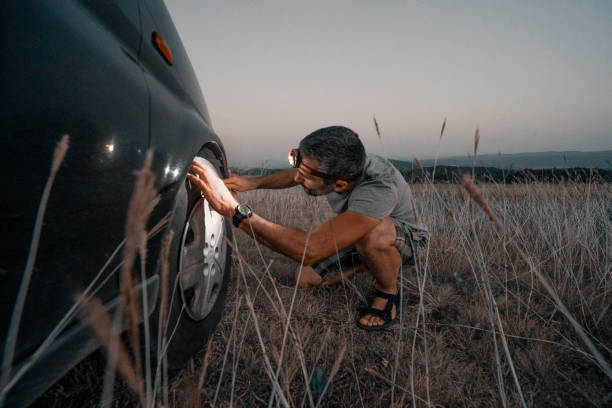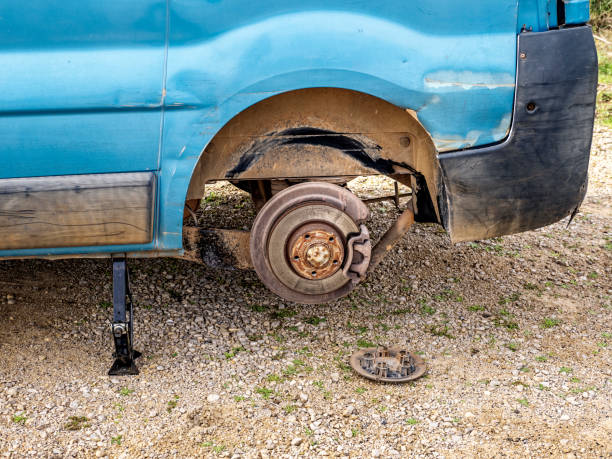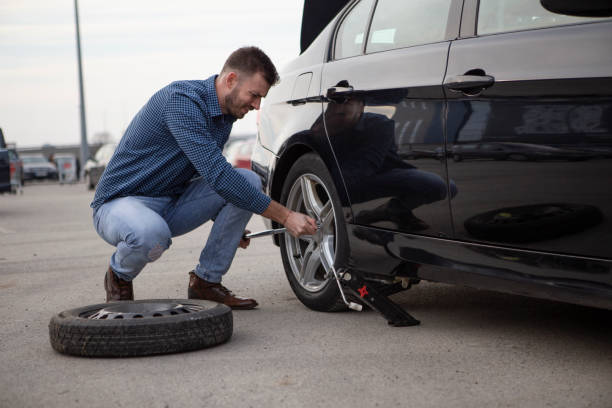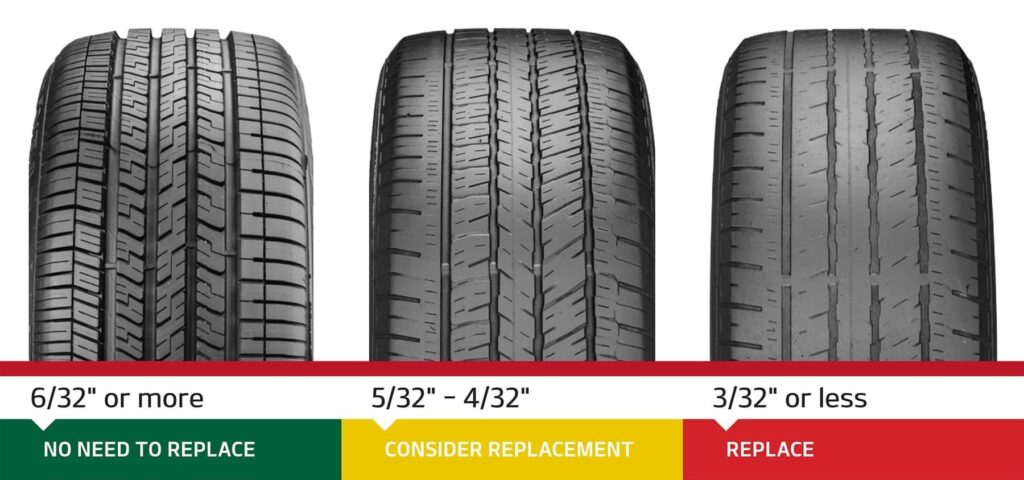Tires need to be replaced when the tread depth reaches 2/32 inches or shows visible damage. Uneven wear patterns also indicate replacement is necessary.
Tires are crucial for vehicle safety and performance. Worn-out tires can lead to accidents and poor handling. Regular inspections help identify when to replace them. Check the tread depth using a penny or a tread depth gauge. Look for visible signs of damage like cracks, bulges, or punctures.
Uneven wear patterns can signal alignment issues or improper inflation. Maintaining proper tire health ensures better fuel efficiency and safer driving. Always replace tires in pairs or sets for balanced performance. Regularly rotating tires can extend their lifespan. Prioritize tire checks for a smoother, safer ride.

Signs Of Tire Wear
Knowing when to replace your tires can save you from accidents. Your safety depends on the condition of your tires. Here are some key signs that indicate your tires need replacing.
Tread Depth
Check the tread depth of your tires regularly. Tread helps your car grip the road. Use a penny to test the depth. Insert the penny into the tread with Lincoln’s head upside down. If you see all of Lincoln’s head, it’s time to replace the tire.
Another way to measure tread depth is using a tread depth gauge. A tread depth of 2/32 inches or less means it’s time for new tires.
- Good Tread Depth: Above 4/32 inches
- Warning Tread Depth: 3/32 inches
- Danger Tread Depth: 2/32 inches or less
Visible Damage
Inspect your tires for any visible damage. Look for cuts, cracks, or bulges. These can lead to tire failure.
Check for punctures or embedded objects. A nail or screw can cause a slow leak. If you find any of these, replace your tire immediately.
| Type of Damage | Action Needed |
|---|---|
| Cracks or Cuts | Replace Tire |
| Bulges | Replace Tire |
| Punctures | Repair or Replace |
Also, check the sidewalls of the tire. Any damage here means the tire needs replacing.

Tire Age
Understanding the age of your tires is crucial for safety. Tires wear out over time, even if they look fine. Knowing when to replace them ensures your safety on the road.
Manufacture Date
Each tire has a unique code on its sidewall. This code reveals the manufacture date of the tire. Look for the DOT number. The last four digits represent the week and year of production. For example, “3519” means the tire was made in the 35th week of 2019.
Check the manufacture date regularly. Old tires can become unsafe, even if they have tread left. Tires older than six years should be inspected by a professional.
Recommended Lifespan
Most tire manufacturers suggest a recommended lifespan for their products. Generally, tires should be replaced every six to ten years. This depends on usage, storage, and driving conditions.
- Up to 5 years: Regular inspections are crucial.
- 6 years: Consider replacing, even if tread seems fine.
- 10 years: Replace immediately, regardless of condition.
Always follow the manufacturer’s recommendations. Check the owner’s manual for specific advice on your vehicle’s tires.
Performance Issues
Performance issues indicate that your tires may need replacing. These issues affect driving safety and comfort. Addressing them promptly can prevent accidents.
Handling Problems
Poor handling is a clear sign of tire trouble. If your car drifts or pulls to one side, your tires could be worn out. Uneven tread can cause this problem.
Check for these issues:
- Car pulling to one side
- Difficulty steering
- Unresponsive braking
If you experience these, inspect your tires immediately.
Noise And Vibration
Unusual noise or vibration suggests tire issues. These can be dangerous if ignored.
Common signs include:
- Thumping sounds
- Excessive vibration in the steering wheel
- Uneven or loud tire noise
These issues may indicate misalignment or tire damage.
Regular inspections can catch these problems early.

Weather Conditions
Weather conditions greatly affect your tires. Understanding these effects can help determine the best time for tire replacement. Different weather patterns impact tire wear, and being aware of these can increase safety and performance.
Seasonal Changes
Seasonal changes play a crucial role in tire health. During winter, cold temperatures can cause the rubber to stiffen, reducing grip. In contrast, hot summer days can increase tire pressure, leading to uneven wear.
- Winter: Snow and ice demand tires with better tread.
- Summer: High heat can cause blowouts if tires are worn.
- Spring/Fall: Wet roads require good tread for water evacuation.
Temperature Effects
Temperature changes can affect tire performance significantly. Extreme temperatures can lead to tire damage, requiring timely replacement.
| Temperature | Effect on Tires |
|---|---|
| High Heat | Increases pressure, risks blowouts |
| Cold | Rubber stiffens, reduced grip |
| Moderate | Optimal tire performance |
Ensure your tires match the seasonal demands. Doing so increases safety and tire lifespan. Regular checks are essential during extreme weather.
Regular Inspections
Regular tire inspections are essential for maintaining safety and performance. They help you spot issues early and prevent accidents. Regular inspections can also extend the lifespan of your tires.
Visual Checks
Performing visual checks is a simple way to monitor tire condition. Look for visible signs of damage, such as cracks, bulges, or punctures. Inspect the tire treads to ensure they are not worn out.
- Check for uneven wear patterns.
- Look for embedded objects like nails or glass.
- Inspect the sidewalls for cuts or bruises.
Use a penny to check tread depth. Insert the penny into the tread groove with Lincoln’s head facing down. If you can see the top of Lincoln’s head, the tread is too worn.
Professional Assessments
While visual checks are helpful, professional assessments provide a more thorough evaluation. Visit a tire shop for an expert inspection. Professionals use specialized tools to measure tread depth and check for internal damage.
- They use tread depth gauges for accurate measurements.
- They inspect for alignment issues and balance.
- They check for tire pressure and adjust if needed.
Regular professional assessments can identify problems that visual checks might miss. Schedule these assessments at least twice a year for optimal tire health.
Tire Maintenance
Proper tire maintenance is crucial for safe driving and extending tire life. Regular checks and care help avoid unexpected issues and ensure smooth rides. Let’s dive into essential aspects of tire maintenance.
Proper Inflation
Maintaining the correct tire pressure is vital. Under-inflated tires can cause uneven wear and increased fuel consumption. Over-inflated tires reduce traction and can lead to a bumpy ride.
Use a tire pressure gauge to check pressure. Refer to your car’s manual for the recommended pressure. Check tires monthly and before long trips.
| Tire Condition | Action |
|---|---|
| Under-Inflated | Add air to the recommended level |
| Over-Inflated | Release air to the recommended level |
Rotation And Balancing
Rotating and balancing tires ensures even wear. This practice extends tire life and improves performance.
- Rotation: Change the position of tires every 5,000 to 8,000 miles. Follow the pattern recommended in your car’s manual.
- Balancing: Balancing tires prevents vibrations and uneven wear. Get tires balanced whenever you notice a vibration or during rotations.
Regular tire maintenance keeps your car running smoothly and safely. Keep an eye on your tires to ensure they last longer.
Warning Indicators
Knowing when to replace your tires ensures safety on the road. Recognizing warning indicators can prevent accidents and improve vehicle performance. Pay attention to specific signs to determine if your tires need replacing.
Dashboard Lights
Modern vehicles have dashboard lights that alert you to tire issues. A tire pressure monitoring system (TPMS) light indicates low pressure. Low pressure can cause uneven tire wear. Check your tires when this light appears. Replace if necessary.
Manufacturer Alerts
Manufacturers provide guidelines for tire replacement. Check your vehicle’s manual for these manufacturer alerts. Follow their recommendations for best results. They often specify mileage limits for tire usage. Adhering to these limits ensures your tires remain in good condition.
Choosing New Tires
Choosing new tires can be overwhelming. There are many factors to consider. Below, we break down some key points to help you decide.
Tire Types
There are various tire types for different needs. Knowing the differences helps you make a better choice.
- All-Season Tires: Good for most weather conditions. They offer a balance of grip and longevity.
- Winter Tires: Best for snowy and icy roads. They have deeper treads for better traction.
- Performance Tires: Designed for sports cars. They offer better handling and speed.
- All-Terrain Tires: Perfect for off-road adventures. They are durable and have rugged treads.
Budget Considerations
Your budget plays a crucial role in your tire choice. Here are some things to think about:
| Budget Range | Expected Features |
|---|---|
| Low Budget | Basic performance, shorter lifespan. |
| Mid-Range | Good performance, decent lifespan. |
| High Budget | Excellent performance, longer lifespan. |
Consider the cost per mile when evaluating tires. A more expensive tire could last longer, saving you money in the long run.
Frequently Asked Questions
How Do I Know If My Tires Need To Be Changed?
Check for tread wear indicators, bulges, cracks, or punctures. Uneven wear and vibrations also signal a need for new tires.
What Are The Three Signs That You May Need New Tires?
Three signs you need new tires: tread wear indicators showing, frequent air pressure loss, and visible cracks or bulges.
When Should You Consider Replacing Tires?
Replace tires when tread depth is below 2/32 inch, sidewalls are cracked, or tires are over six years old. Check for uneven wear and frequent air pressure loss. Regularly inspect tires for damage or punctures.
How Do You Know If Your Tyres Need Replacing?
Check tyre tread depth. Look for uneven wear, bulges, or cracks. Notice vibrations or handling issues. Replace if damaged or worn.
Conclusion
Regular tire checks ensure safety and optimal performance. Replace tires showing wear, damage, or aging signs. Prioritize tire maintenance to avoid unexpected issues. Stay attentive to tread depth, cracks, and bulges. Your vehicle will thank you with a smoother, safer ride.
Keep your journeys safe by addressing tire needs promptly.





















